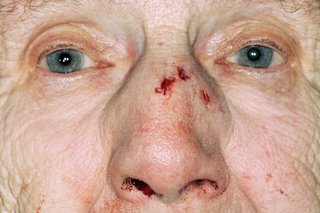A broken nose usually heals on its own within 3 weeks. Get medical help if it's not getting better or your nose has changed shape.
Check if it's a broken nose
Symptoms of a broken nose may include:
- pain, swelling and redness
- a crunching or crackling sound when you touch your nose
- difficulty breathing out of your nose – it might feel blocked
- your nose changing shape – for example, it's not as straight as before
You may also have:

DR P. MARAZZI/SCIENCE PHOTO LIBRARY

DR P. MARAZZI/SCIENCE PHOTO LIBRARY
How to treat a broken nose yourself
You can usually treat a broken nose yourself. It should start getting better within 3 days and be fully healed within 3 weeks.
Do
- hold an ice pack (or frozen peas) wrapped in a tea towel on your nose for up to 15 minutes, several times a day
- take paracetamol or ibuprofen to relieve the pain
- treat nosebleeds by sitting or standing upright and leaning forward – if possible, pinch your nose above the nostrils for up to 15 minutes
- keep your head upright when lying in bed by adding more pillows – this will help to reduce swelling
- read how to treat minor cuts and grazes – if you have a small cut on your nose
Don't
- do not try to straighten your nose yourself if it's changed shape – see a GP instead
- do not wear glasses until the swelling has gone down, unless you need them
- do not pick or blow your nose until it's healed
- do not do strenuous exercise for the first 2 weeks
- do not play sports where your face might be hit for at least 6 weeks
Non-urgent advice: Go to a minor injuries unit or see a GP if:
- your nose is crooked (not straight) after the injury
- the swelling hasn't started to go down after 3 days
- painkillers aren't helping
- you're still finding it difficult to breathe through your nose after the swelling has gone
- you're having regular nosebleeds
- you have a very high temperature (or you feel hot and shivery)
- you have a large cut on your face
Immediate action required: Call 999 or go to A&E if you have a broken nose and:
- a nosebleed that won't stop
- a large open wound on your nose – or something else still in the wound, such as glass
- clear, watery fluid trickling from your nose – this could be a sign of a serious head injury
- a severe headache with blurred or double vision
- eye pain and double vision
- neck pain or a stiff neck – with numbness or tingling in your arms
- a blood clot in the skin between your nostrils (septum) – it may be painful, swollen or block your breathing
- other symptoms of a severe head injury – such as collapsing (passing out) or difficulty speaking
Treatment from a GP
Your GP might prescribe stronger painkillers if paracetamol or ibuprofen aren't helping.
If you have a large cut, a nurse or GP may clean the wound and recommend something to seal or protect it – for example, stitches or strips of surgical tape.
If you have a severe broken nose or it's changed shape, you may be referred to a specialist in hospital for assessment and treatment.
Treating a severe broken nose in hospital
If your nose has changed shape
A doctor in hospital may be able to make your nose straighter using a procedure called manipulation.
You might have to go home and wait a few days for the swelling to go down, but the procedure should be done within 14 days.
Manipulation is done using anaesthetic so that you're asleep or your nose is numbed. It doesn't always make your nose look exactly the same as it was before, but it often helps.
If you have a large wound
The wound will usually be cleaned and sealed with stitches or strips in hospital.
If your nose won't stop bleeding
A doctor may place a soft gauze pad in your nose. The pad will be removed by the doctor a few days later.
Page last reviewed: 26 September 2017
Next review due: 26 September 2020
